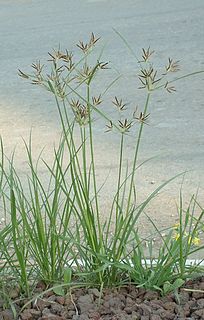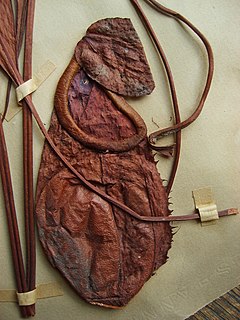
Cyperus papyrus, better known by the common names papyrus, papyrus sedge, paper reed, Indian matting plant, or Nile grass, is a species of aquatic flowering plant belonging to the sedge family Cyperaceae. It is a tender herbaceous perennial, native to Africa, and forms tall stands of reed-like swamp vegetation in shallow water.

The Cyperaceae are a family of graminoid (grass-like), monocotyledonous flowering plants known as sedges. The family is large, with some 5,500 known species described in about 90 genera, the largest being the "true sedges" genus Carex with over 2,000 species.

Cyperus is a large genus of about 700 species of sedges, distributed throughout all continents in both tropical and temperate regions.

Sterculia is a genus of flowering plants in the mallow family, Malvaceae: subfamily Sterculioideae. Members of the genus are colloquially known as tropical chestnuts. The scientific name is taken from Sterculius of Roman mythology, who was the god of manure; this is in reference to the unpleasant aroma of the flowers of this genus. Sterculia may be monoecious or dioecious, and flowers unisexual or bisexual.

Cyperus rotundus is a species of sedge (Cyperaceae) native to Africa, southern and central Europe, and southern Asia. The word cyperus derives from the Greek κύπερος, kyperos, and rotundus is from Latin, meaning "round". The earliest attested form of the word cyperus is the Mycenaean Greek 𐀓𐀞𐀫, ku-pa-ro, written in Linear B syllabic script.

Nepenthes thorelii is a tropical pitcher plant endemic to Indochina. Very little is known about N. thorelii and it is unlikely to have entered cultivation, although various other taxa are often mislabelled as this species in the plant trade. Prior to its rediscovery in 2011, N. thorelii was considered possibly extinct, both in the wild and in cultivation.
Hopea thorelii is a species of plant in the family Dipterocarpaceae. The species is named after the French botanist Clovis Thorel. It is found in Laos and Thailand.
Shorea thorelii is a highly vulnerable species of Asian trees, described by Pierre and Lanessan, which is included in the genus Shorea and family Dipterocarpaceae; the species is named after the French botanist Clovis Thorel. No subspecies are listed in the Catalogue of Life.

Cyperus eragrostis is a species of sedge known by several common names, including tall flatsedge, nutgrass, tall nutgrass, umbrella sedge, chufa, Earth almond, zula nuts, edible galingale and pale galingale.

Cyperus fuscus is a species of sedge known by the common name brown galingale, or brown flatsedge. This plant is native to much of Europe, Asia and North Africa from England, Portugal and Morocco east to China and Thailand. It is an introduced species in North America, where it is naturalized in widely scattered locations in the United States and Canada.

Themeda is a genus of plants in the grass family native to Asia, Africa, Australia, and Papuasia. There are about 18 to 26 species, many of which are native to Southeast Asia.

Cyperus scariosus is a perennial herbaceous plant from Australia and New Guinea.

Nepenthes bokorensis is a tropical pitcher plant endemic to Cambodia. It is known from Mount Bokor in the south of the country, and an as yet undetermined specimen suggests that it may also be present in other parts of the Dâmrei Mountains of Kampot Province. The specific epithet bokorensis refers to both Mount Bokor and Bokor National Park.
Nepenthes 'Amy Michelle' is a cultivar of a manmade hybrid between N. rafflesiana and a plant identified as N. thorelii. It was bred by Bruce Lee Bednar and Orgel Clyde Bramblett in 1989. This cultivar name is not established as it was published without a description, violating Article 24.1 of the International Code of Nomenclature for Cultivated Plants. It is a later synonym of N. 'Delectable Koto'. The cultivar name 'Amy Michelle' first appeared in print in the March 1994 issue of the Carnivorous Plant Newsletter as "x “Amy Michelle”". Bednar and Bramblett listed its parentage as "thorelii x rafflesiana nivea".
Nepenthes 'Vittata' is a cultivar of a complex manmade hybrid involving N. maxima, N. mirabilis, N. northiana, N. rafflesiana, N. veitchii, and a plant identified as N. thorelii. It was bred by Bruce Lee Bednar and Orgel Clyde Bramblett in 1990. This cultivar name is not established as it was published without a description, violating Article 24.1 of the International Code of Nomenclature for Cultivated Plants, and has a Latin epithet, violating Article 19.13. It is a synonym of N. × hareliana and was originally published in the March 1994 issue of the Carnivorous Plant Newsletter as "x hareliana var. vittata".
Nepenthes 'Dwarf Peacock' is a cultivar of a complex manmade hybrid involving N. khasiana, N. ventricosa, and a plant identified as N. thorelii. It was bred by Bruce Lee Bednar and Orgel Clyde Bramblett in 1986. This cultivar name is not established as it was published without a description, violating Article 24.1 of the International Code of Nomenclature for Cultivated Plants. It first appeared in print in the March 1994 issue of the Carnivorous Plant Newsletter as "x “Dwarf Peacock”". Bednar and Bramblett listed its parentage as "thorelii x Savanah Rose" [sic].
Quercus thorelii is an Asian species of tree in the family Fagaceae and the "ring-cupped oak" sub-genus; the species is named after the French botanist Clovis Thorel. It has been found in Indochina and in southern China.










